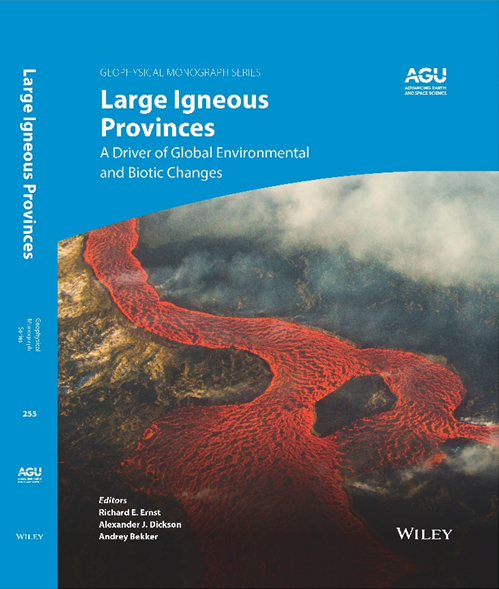March 2021 LIP of the Month
Large Igneous Provinces: A Driver of Global Environmental and Biotic Changes
(American Geophysical Union, Geophysical Monograph 255, January 2021)
https://agupubs.onlinelibrary.wiley.com/doi/book/10.1002/9781119507444
Open Access for free download
Richard E. Ernst (1), Alexander J. Dickson (2), Andrey Bekker (3) (Editors)
1 Carleton University, Canada & Tomsk State University, Russia; Richard.Ernst@ErnstGeosciences.com
2 Royal Holloway University of London, UK; alex.dickson@rhul.ac.uk
3 University of California at Riverside, USA & University of Johannesburg,
South Africa; andreyb@ucr.edu

Large Igneous Provinces: A Driver of Global Environmental and Biotic Changes provides an overview of the role of Igneous Provinces (LIPs) and Silicic LIPs (SLIPs) as significant drivers of dramatic global environmental and biological changes, including mass extinctions. Environmental changes caused by LIPs and SLIPs can include rapid global warming, global cooling ('Snowball Earth'), oceanic anoxia events, mercury poisoning, atmospheric and oceanic acidification, and sea level changes. This new 21-chapter volume (published in January 2021) is OPEN ACCESS; therefore, all chapters and indeed the entire book can be downloaded for free. https://agupubs.onlinelibrary.wiley.com/doi/book/10.1002/9781119507444
Here is a list of the 21 chapters in AGU GM255.
PART I: THE TEMPORAL RECORD OF LARGE IGNEOUS PROVINCES (LIPS)
Chapter 1: Large Igneous Province Record Through Time and Implications for Secular Environmental Changes and Geological Time-Scale Boundaries. Richard E. Ernst, David P. G. Bond, Shuan-Hong Zhang, Kenneth L. Buchan, Stephen E. Grasby, Nasrrddine Youbi, Hafida El Bilali, Andrey Bekker, and Luc S. Doucet
Chapter 2: Radiometric Constraints on the Timing, Tempo, and Effects of Large Igneous Province Emplacement. Jennifer Kasbohm, Blair Schoene, and Seth Burgess
PART II: ENVIRONMENTAL IMPACTS OF LIP EMPLACEMENT
Chapter 3: Global Warming and Mass Extinctions Associated With Large Igneous Province Volcanism. David P. G. Bond and Yadong Sun
Chapter 4: Environmental Effects of Volcanic Volatile Fluxes From Subaerial Large Igneous Provinces. Tamsin A. Mather and Anja Schmidt
Chapter 5: Assessing the Environmental Consequences of the Generation and Alteration of Mafic Volcaniclastic Deposits During Large Igneous Province Emplacement. Benjamin Black, Tushar Mittal, Francesca Lingo, Kristina Walowski, and Andres Hernandez
Chapter 6: Environmental Impact of Silicic Magmatism in Large Igneous Province Events. Scott E. Bryan
Chapter 7: Evaluating the Relationship Between the Area and Latitude of Large Igneous Provinces and Earth’s Long-Term Climate State. Yuem Park, Nicholas L. Swanson-Hysell, Lorraine E. Lisiecki, and Francis A. Macdonald
Chapter 8: Preliminary Appraisal of a Correlation Between Glaciations and Large Igneous Provinces Over the Past 720 Million Years. Nasrrddine Youbi, Richard E. Ernst, Ross N. Mitchell, Moulay A. Boumehdi, Warda El Moume, Abdelhak Ait Lahna, Mohamed K. Bensalah, Ulf Söderlund, Miguel Doblas, and Colombo C. G.Tassinari
Chapter 9: Phanerozoic Large Igneous Province, Petroleum System, and Source Rock Links. Steven C. Bergman, James S. Eldrett, and Daniel Minisini
PART III: GEOCHEMICAL PROXIES FOR THE ENVIRONMENTAL EFFECTS OF LIPS
Chapter 10: The Osmium Isotope Signature of Phanerozoic Large Igneous Provinces. Alexander J. Dickson, Anthony S. Cohen, and Marc Davies
Chapter 11: Sedimentary Mercury Enrichments as a Tracer of Large Igneous Province Volcanism. Lawrence M. E. Percival, Bridget A. Bergquist, Tamsin A. Mather, and Hamed Sanei
Chapter 12: Platinum Group Element Traces of CAMP Volcanism Associated With Low-Latitude Environmental and Biological Disruptions. Jessica H. Whiteside, Paul E. Olsen, Sean T. Kinney, and Mohammed Et-Touhami
Chapter 13: Assessing the Effect of Large Igneous Provinces on Global Oceanic Redox Conditions Using Non-traditional Metal Isotopes (Molybdenum, Uranium, Thallium). Brian Kendall, Morten B. Andersen, and Jeremy D. Owens
Chapter 14: Marine Anoxia and Ocean Acidification During the End-Permian Extinction: An Integrated View From δ238U and δ44/40Ca Proxies and Earth System Modeling. Ying Cui, Feifei Zhang, Jiuyuan Wang, Shijun Jiang, and Shuzhong Shen
Chapter 15: Trends in Ocean S-Isotopes May Be Influenced by Major LIP Events. Ross. R. Large, Jeffrey A. Steadman, Indrani Mukherjee, Ross Corkrey, Patrick Sack,
and Trevor R. Ireland
Chapter 16: Marcasite at the Permian-Triassic Transition: A Potential Indicator of Hydrosphere Acidification. Elena Lounejeva, Jeffrey A. Steadman, Thomas Rodemann, Ross R. Large, Leonid Danyushevsky, Daniel Mantle, Kliti Grice, and Thomas J. Algeo
PART IV: PHANEROZOIC AND PROTEROZOIC CASE HISTORIES
Chapter 17: The Monterey Event and the Paleocene-Eocene Thermal Maximum: Two Contrasting Oceanic Carbonate System Responses to LIP Emplacement and Eruption. Tali L. Babila and Gavin L. Foster
Chapter 18: Permian Large Igneous Provinces and Their Paleoenvironmental Effects. Jun Chen and Yi-Gang Xu
Chapter 19: Was the Kalkarindji Continental Flood Basalt Province a Driver of Environmental Change at the Dawn of the Phanerozoic? Peter E. Marshall, Luke E. Faggetter, and Mike Widdowson
Chapter 20: Large Igneous Provinces (LIPs) and Anoxia Events in “The Boring Billion”. Shuan-Hong Zhang, Richard E. Ernst, Jun-Ling Pei, Yue Zhao, and Guo-Hui Hu
Chapter 21: Breaking the Boring Billion: A Case for Solid-Earth Processes as Drivers of System-Scale Environmental Variability During the Mid-Proterozoic. Charles W. Diamond, Richard E. Ernst, Shuan-Hong Zhang, and Timothy W. Lyons
